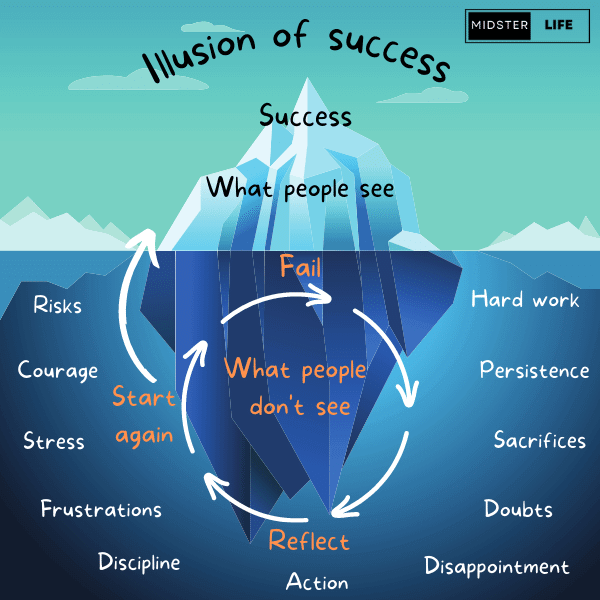The 10 must-have traits to start over in your 40s
While everyone is more than capable of making changes at any stage of their life, only some do. But why?
Are some people just more predisposed to be able to make changes to their lives? Do they have something the rest of us don’t?
Let’s examine what characteristics are needed to make significant changes to your life after 40.
Have you got what it takes to change your life?
1). Courage
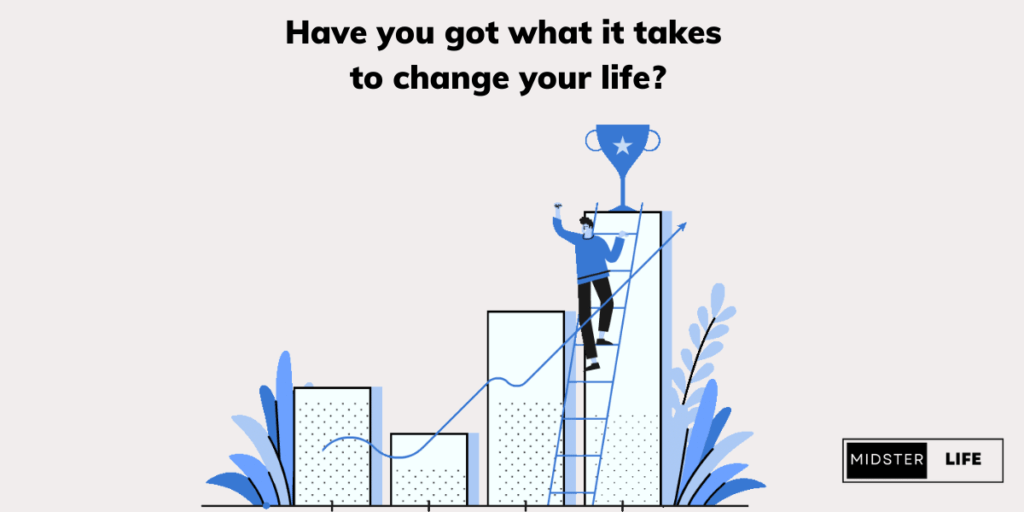
It isn’t easy to be honest with yourself that something in your life isn’t working or how you’d like it to be. Being brave enough to admit that you want to change aspects of your life is the first step to making any change.
A good starting point is to look at the different areas of your life and be honest about how happy you are with each one. Are you satisfied with where you are in terms of your career but feel dissatisfied with your health and fitness levels?
How satisfied are you with the relationships in your life? Have you lost touch with friends that matter, or are there family members you lack connection with and are draining?
Be honest about where you are in each area of your life, and use this as a starting point on what action to take next.
Finding the courage to then move from the known to the unknown and step outside of your comfort zone is critically important.
This can be smaller than you think. You might decide to quit your job or move to that city just like that (I wouldn’t advise such drastic action without careful planning, though).
Or it could be something as simple as signing up for that evening course or asking that friend about that job they mentioned the other day.
But you must be willing and brave enough to take those first steps.
2). Patience
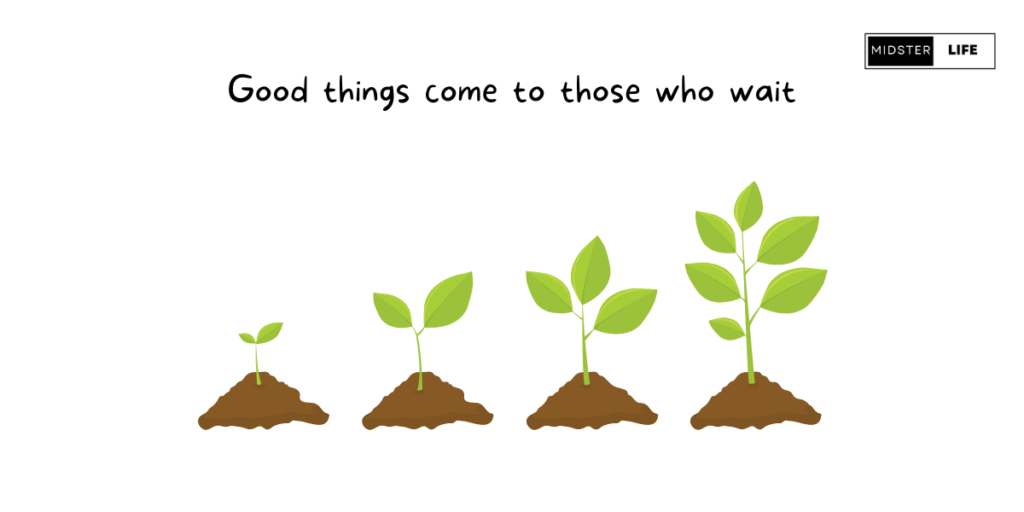
It would be great to wake up one day with all our dreams fulfilled.
Unfortunately, the reality is a bit different.
Magical and instantaneous transformation is a myth. Growth takes time and effort.
We have millions of neurons and ingrained pathways in our brains. Changing these requires billions of new connections, which takes time once we expose ourselves to new experiences.
You’ll need patience as you work towards the new you.
However, patience is the most challenging quality when changing mid-life. You may feel like time is running out.
It can feel like an unthinkable task to tell someone to be patient when changing in their 40s.
“I haven’t got the time left to start over from the bottom.”
These worries may be rooted in genuine practical concerns around finances and the difficulties in working up from the bottom at a point in your life where your financial responsibilities are high. But the simple truth is there are no shortcuts.
If you want something to be different, you’ve got to put in the effort, which will take time.
Change and success are not always linear. What starts as the plan may change along the way as you adjust based on your experiences and challenges.
Consider, will you get bored and frustrated if things don’t go to plan or progress is slow? How will you overcome this?
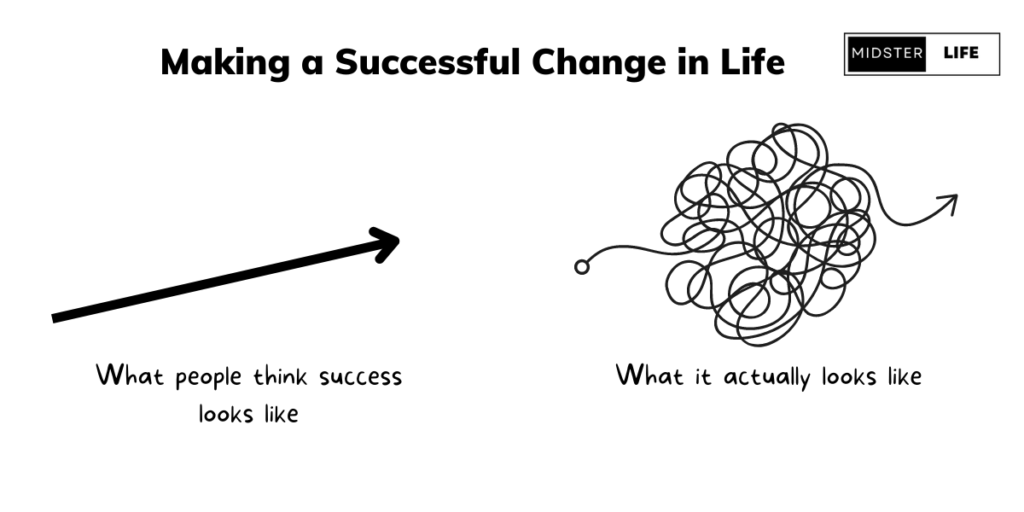
“Overnight success stories take a long time”
Steve Jobs
3). Grit
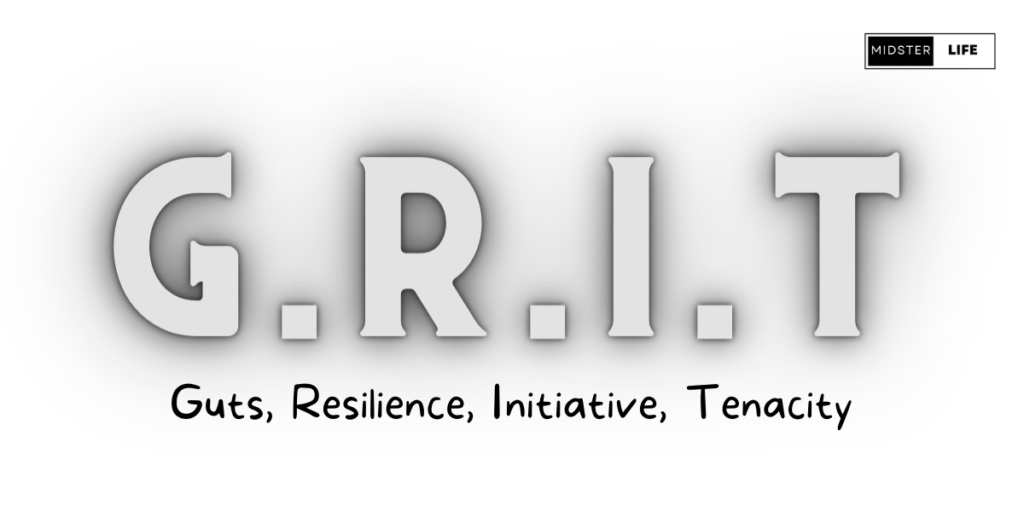
Because change takes time, it’s not just patience that will be the difference between success and failure but also grit.
Psychologist and author Angela Duckworth defines grit as:
“Passion and sustained persistence applied toward long-term achievement.”
Angela Duckworth
Grit combines resilience, ambition, and self-control in pursuing goals that can take months or even years.
You may believe you have a skill for something in particular or a passion and belief that you can potentially become good at something, but talent alone is not enough; “without effort, your talent is nothing more than your unmet potential.” – Angela Duckworth.
Angela Duckworth’s grit formula further defines this:
Talent x Effort = SKILL
Skill x Effort = Achievement.
As you can see, talent counts once, but effort counts twice.
But what if I’m not gritty enough?
We can all look back on events in our past where we’ve given up on something or not followed through. Don’t let this define you going forward.
Angela Duckworth’s research identifies that grit can grow and be developed; it’s not fixed. And there is a correlation between grit scores increasing and age.
So being a mid-life changer comes with the added benefit that you have more grit now than at earlier periods of your life.

Don’t give up too early
Yeah, sure, there will be barriers to overcome.
You will need to stay motivated when you feel like giving up, and sometimes, you will need to push yourself to do the things you know you need to do even though you don’t want to do them.
But ask yourself, can I overcome the internal narratives I tell myself? e.g., “I can’t do this.” “I always give up.”
Can I overcome the external barriers and problems that will arise as I try to make the change? E.g., an illness or change in personal circumstances.
Or bounce back from the small everyday failures?
And if you are unsure, what actions or mitigations can you implement to help you deal with potential setbacks?
Can you build the habits that ensure you turn up every day and take positive action (however small) towards your goal?
4). Positive mindset
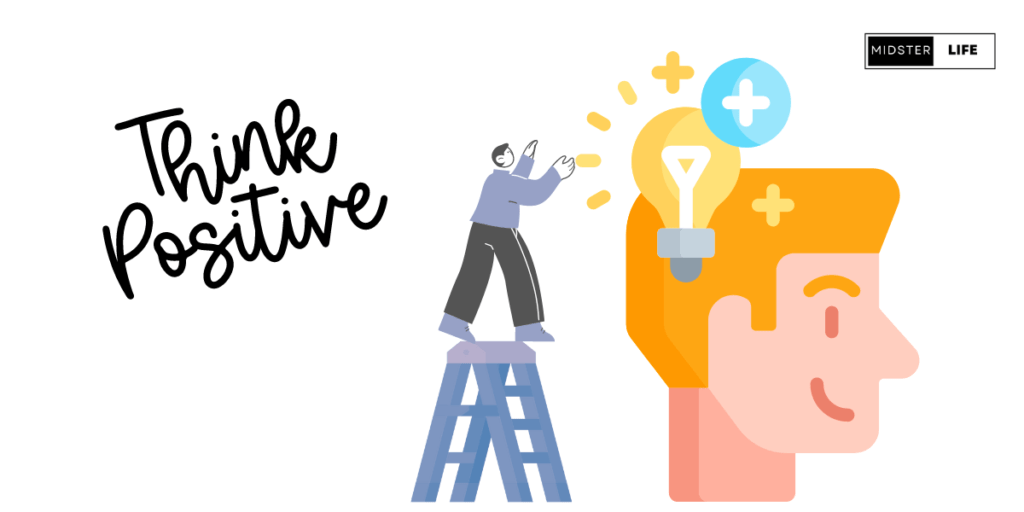
The definition of self-doubt is experiencing uncertainty about one or several aspects of your life. Self-doubt is entirely normal and can help motivate you to improve your skills. It is essential, however, not to let self-doubt overwhelm you.
The ability to manage self-doubt and to channel it positively is vital when trying to change your life.
Some strategies to help you build a positive mindset include:
- Think about your past achievements. Use these to give you confidence. Consider the challenges you’ve overcome, no matter how small, and how they made you feel when you achieved what you set out to.
- Don’t let negative experiences in the past create a narrative for the future. Thoughts like “I always…(fail/give up) or “Im not (smart/determined enough..)” are too definite. The past does not dictate the future.
- Use the “until now…” strategy to deal with these thoughts. “I’ve always given up…until now”. This way, you frame your past actions in a more positive light that isn’t fixed and is within your control to change.
- Don’t compare yourself to others. You are unique, have unique skills and experiences, and are at a different point in life’s journey than those around you. People that are successful in changing their lives focus on their goals and commit to taking small actions every day rather than comparing themselves to those around them.
- Spend time with people who make you feel good. Create a positive support network around you, with people you trust and believe in your ability to achieve your goals. When you feel self-doubt, these people can offer you the support you need to get back on track.
5). Discipline

No one will stand over you and tell you what to do. Try to stick to your decisions and follow through on them. You have to take responsibility for your own life and actions.
Don’t view this as something negative. It’s actually great. You have control. You can achieve what you want out of your life simply by committing to showing up every day and taking small actions toward your goals.
The benefit of showing up every day is that, over time, it builds confidence.
I’ve used this strategy myself on many occasions. Whatever happens in my life, I always prioritize my fitness and make sure I go for a run or swim each day. Even when I don’t want to, by building discipline in this one area of my life, I can draw on it when facing challenges in other areas.
If you can show up and take action every day in one area of your life, you can do it in another and use this as motivation to build a habit of discipline.
6). Willingness to take risks
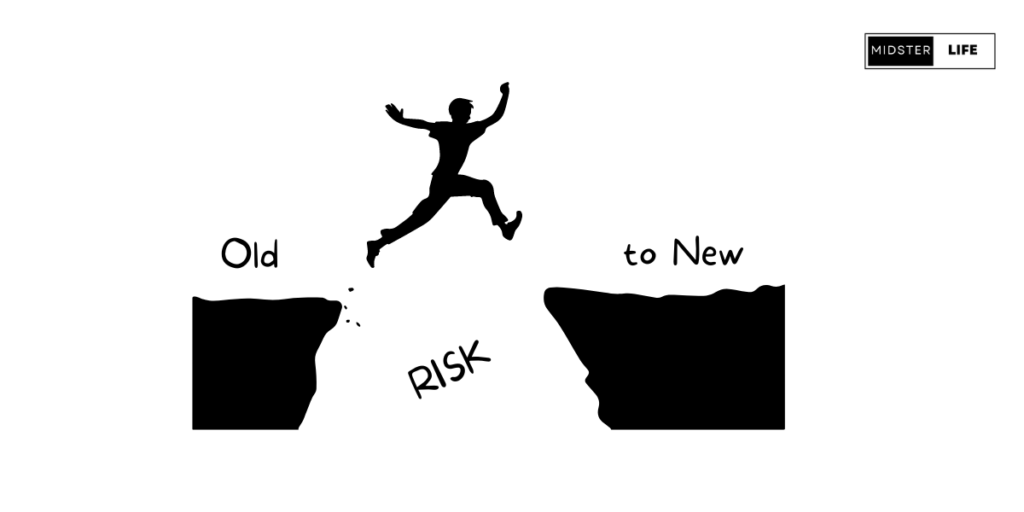
Risk-taking doesn’t have to be jumping out of an airplane or investing all your savings in the latest cryptocurrency. Risk-taking is taking an action that puts you outside your comfort zone.
It may be volunteering to lead that project at work or giving that talk in front of 100 people.
An activity that makes you feel uncomfortable, but by taking the risk, you are growing. Overcoming the fear will give you confidence and self-belief.
Before taking any action, consider what the worst outcome will be.
Example: You want to quit your job and start that dream business.
What’s the worst that can happen?
- The business may fail.
- Everyone will think I’m a failure.
- I may lose my house.
- My wife may leave me.
- My friends will shun me.
- I might end up homeless.
- I might end up selling drugs to pay for food!
- I might end up in prison, sharing a cell with Hairy Harry!
Consider how likely each of these events is. Will there be actions at each step that you can take to prevent them from happening? Are the events at the bottom of the list so ridiculous that they bring perspective to the risk?
Yes?! Don’t let fear hold you back. Consider the risks, plan to mitigate them, and then go for it.
As the famous Nike Ad slogan said, “Just do it.”
7). Action-oriented
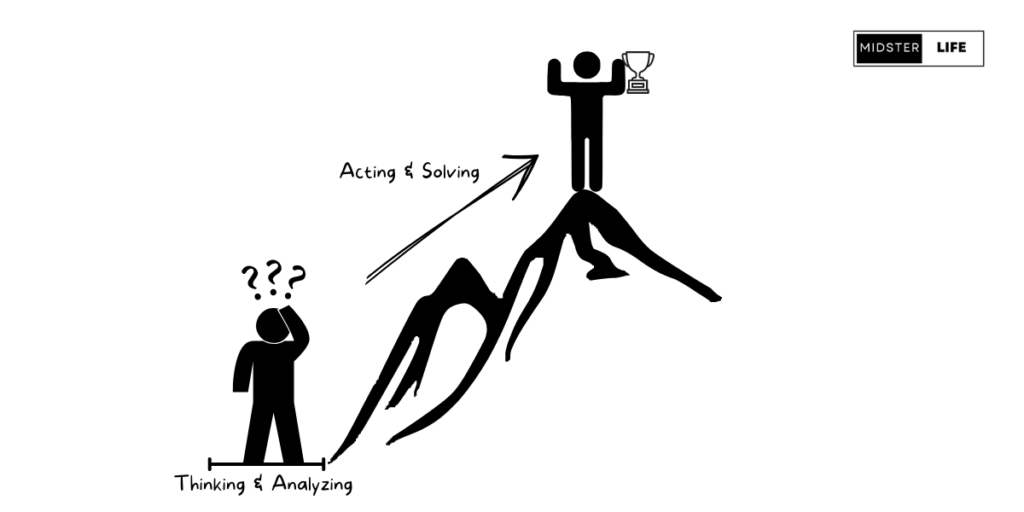
With action, you can move forward with a goal. Action beats everything.
When trying to change something in your life, it’s very easy to get stuck in “Analysis Paralysis” as you consider all options for your next move. It’s impossible to be able to work out all the answers before starting.
Just start and work things out as you go along. By taking action, you will boost your confidence and self-belief. You will beat anxiety and start moving closer to the life you want.
8). Ability to manage stress

Whether it’s a regular meditation practice, woodwork, sports, or simply reading a book in a quiet spot, finding ways to manage stress effectively is essential when trying to transform your life in your 40s.
There will be bumps in the road, and stress management will improve your resilience and ability to stick it out.
Are you self-aware enough to spot when your stress triggers? How does it manifest itself? Are you short-tempered with those around you? Do you have difficulty sleeping? Picking up on the triggers and initial symptoms will help you put stress mitigations in place.
Habit is everything. If you know some activities help you to de-stress, then build them into your schedule, and make sure they have a regular slot that is not movable. Ensuring you keep on top of any stress before you get overwhelmed.
9). Self-reflection
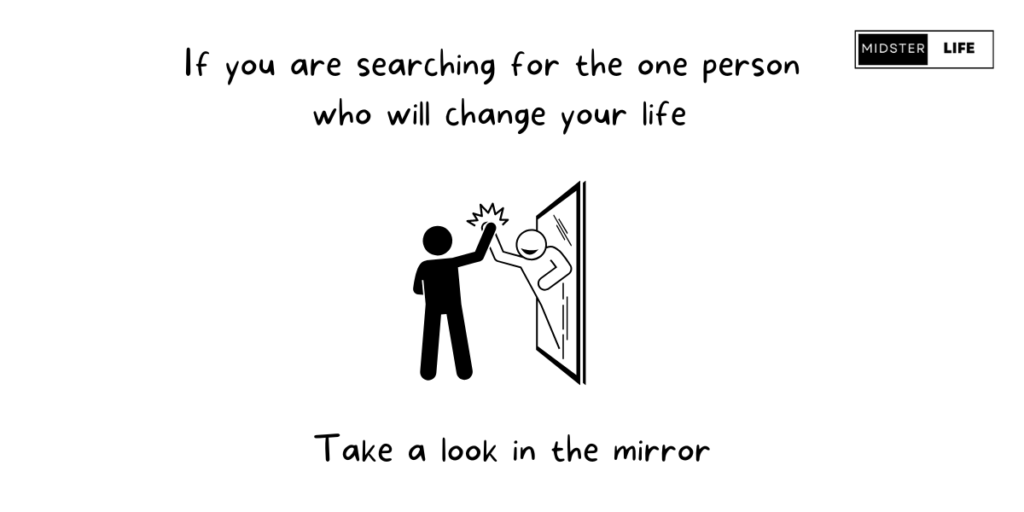
The ability to stop and think about the steps you’ve taken in making a change will help you assess progress.
What has gone well? What do you need to do that is different? Self-reflection on your strengths, weakness, successes, and failures will lead you to make more informed decisions moving forward.
Self-reflection is an integral part of learning that encourages you to question yourself positively. Are there ways of doing things differently? What is working and what isn’t?
Use regular slots for self-reflection, whether weekly, monthly, or quarterly to ensure you check in with where you are versus your goals.
Don’t be afraid to make changes if things aren’t going as planned, but be honest with yourself. Have you given it everything so far? Have you given it enough time? Make sure you can answer yes to these questions before making changes.
10). Sacrifice
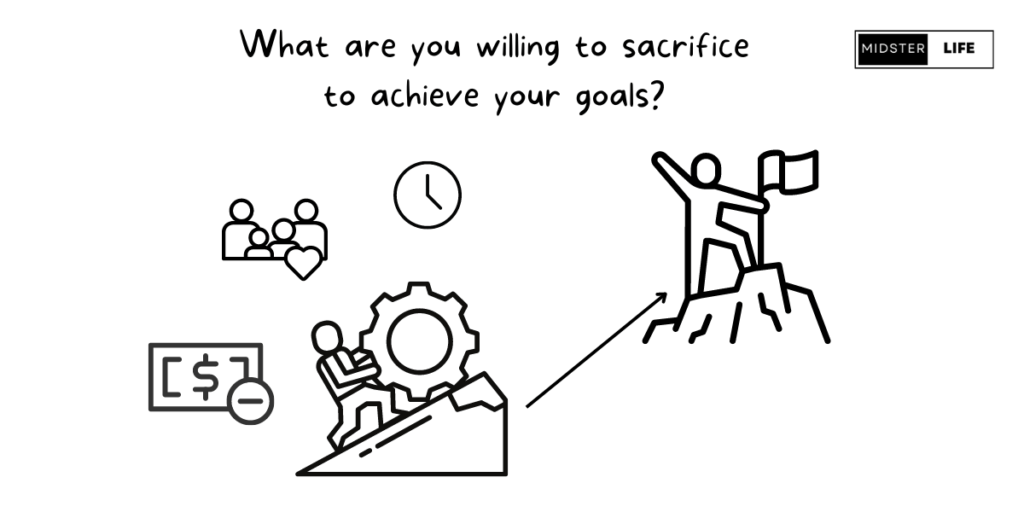
No change can be made without some level of sacrifice. It may be in terms of time, giving up your evenings to study, or work on a side project. Or it may be financial, as you move into a new role that pays less.
The sacrifice could be in terms of your relationships, as you spend less time with your partner or children for a period as you try to get the new business off the ground.
Try to view any sacrifice as temporary. You are temporarily giving up something important to you in pursuing longer-term goals. This sacrifice should not be forever, and once you have achieved what you set out to, you should see the benefits of being able to return and rebalance those areas of your life you’ve sacrificed.
Making significant changes to your life can seem daunting at first, and you may be unsure whether you’ve got what it takes to make the change. But the qualities listed in this article aren’t fixed or reserved only for the special few.
They are accessible to everyone.
Are you still trying to figure out if 40 is too old to start over? Check out this post and find out what it looks like to start over after 40.
Or are you interested in discovering how Play-Doh can inspire you to find a new purpose after 40? Yes? Read this.

